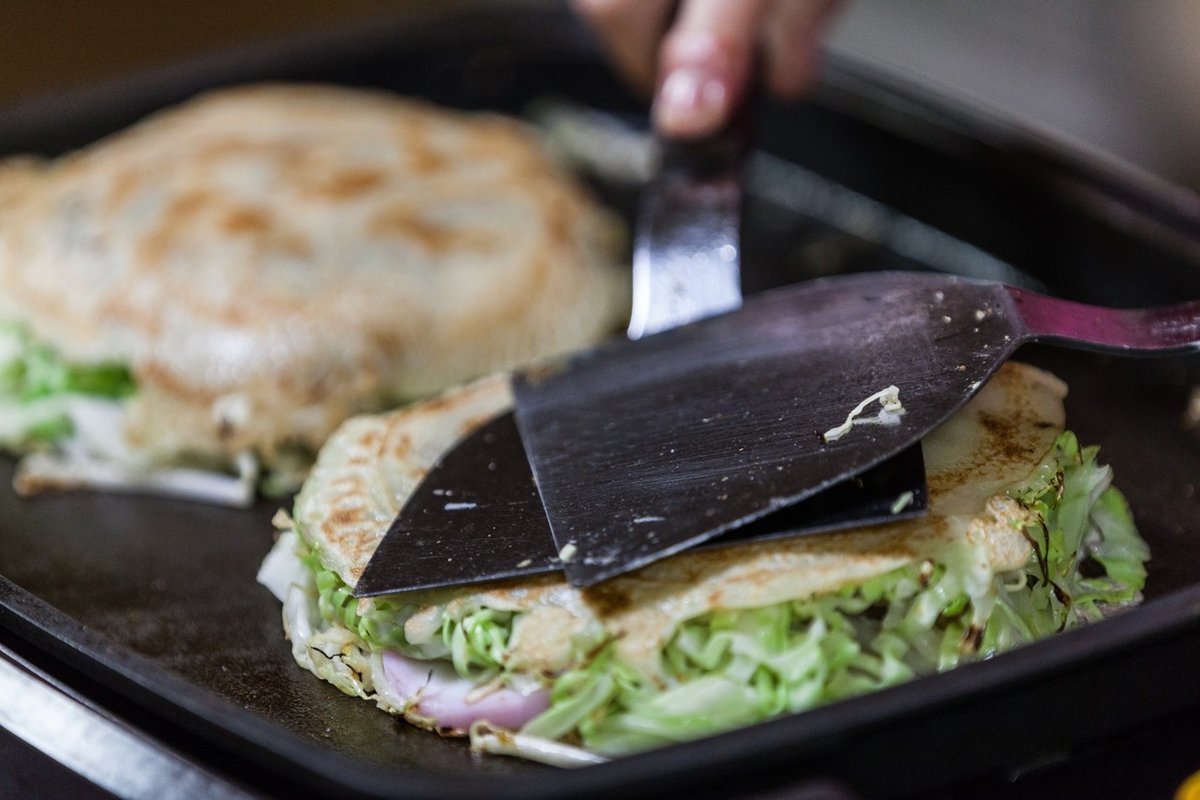
千田町のタズ子さんの「お好み焼き」grandma's life recipes
福山では知らない者はいない老舗和菓子店「虎屋」。江戸時代から400年続く老舗でありながら、最近、なんとも不思議な新商品を打ち出して話題になっていた。「たこ焼きにしか見えないシュークリーム」や「麻婆豆腐みたいなゼリー」や「ざるそばのようなモンブラン」「お好み焼きそっくりなチョコレートケーキ」といった具合。そんな虎屋さんのばあちゃんが、たいへん料理上手だとの噂を聞いて会いに行くことにした。ばあちゃんの料理は、家族や友人、知人、それからお仕事中の営業マンまでも引き寄せて、いつも誰かがごはんを食べているのだという。口々にオススメ料理が挙がるも、ここはひとつ、広島といえばの「お好み焼き」を教わることにした。
福山駅から芦田川と平行に車で北に10分ほど走る。福山市千田町(せんだちょう)の閑静な住宅街に現れた立派なおうち。「いらっしゃい」と親しみやすさたっぷりの笑顔で現れたのは、華やかなマリメッコのエプロンを愛らしく着こなした女性。とても「ばあちゃん」に見えない。玄関を開けると、いい匂いがどっと溢れてきた。こ、これは、かつて何度か遭遇したことのある「料理を習いに来たのに、扉を開けたらもう全部出来上がっていた」のパターンだろうかと慌てていると、「ほら、まず食べて。おでん作っておいたから」と、ぐっと濃い色が染み込んだおでんがタプタプと浸かった土鍋が目の前に。満々に高まっていたやる気も緩んでしまう、もう、なんとも幸せなお誘いだ。

「いやーこのおでんはね、ほんとうまいんだよ。甘辛くて」。向こうのソファーからそう言うのは、息子さんであり「虎屋」16代目の信吾さん。実家のおでんを、お母さんの前で、照れもせずに褒めまくるものだから、私も遠慮なくあれよあれよという間に席に着き、すっかりご馳走になる準備完了。牛スジは柔らかくほろほろととろけて、大根にも余すところなく味が染み渡っている。関東風おでんと名古屋の土手煮の中間のような味付けのおでんだ。立派なスジだな〜と味わっていたら、「私はね、お肉もお魚も行きつけの専門店があってね、あまりスーパーには行かないわね。このスジもそう」と、こだわりが顔を出す。

まったりとした濃いめの味わいが私の口のなかに広がって、「あぁ、ごはんが欲し……」と思ったのを見透かしたように、ヌッと目の前に差し出されたのは、炊きたての新米をふわっと握ったおにぎり! すっかりお腹も心も満たされて、「もう今日のところは帰って、また出直そうか」なんて思った矢先、玄関口からご近所さんの声がした。「はーい」と返事をしながら、おもむろにその人の分のおにぎりも握り出す。「誰かが来たらとにかくご飯を食べさせる」という行動が、もはや反射の域に達しているのだ。友人はもちろん、ご近所さんや外回りの銀行員さんまでが家に上がって食卓に着き、ご飯を食べて帰るのだという。いやきっと、銀行員さんたちは偶然を装いながら、ごはん時を狙って訪問しているに違いない、と想像するとニヤニヤしてしまう。

さて、私が自己紹介をしてもしなくてもどんどんご飯を食べさせてくれたこのばあちゃん。遅ればせながら、お名前は、高田タズ子さん。81歳。
これからタズ子さんが作ってくれるのは、何を隠そう、「お好み焼き」。「学生の頃、地元の庄原市から出て広島市でガスも通っていないような家で下宿を始めたの。その下宿先の近所にお好み焼き屋さんがあってね、それがお好み焼きと私の初めての出会いだったのよ。お店に通って、見て学んだの」。そう話しながらちゃきちゃきと準備が進む。

薄力粉1カップに水1カップ、顆粒出汁とお塩を少々入れて混ぜた生地を、熱したホットプレートの上に薄く伸ばす。そのクレープ状の生地の上に、とろろ昆布とイカ天、天かす、そしてこれでもかというほどのキャベツともやしをどさっと乗せる。

具材たちのつなぎとして上から生地をすこーしかけて、かまぼこと豚肉を乗せたら一気にひっくり返す。さすが熟練の手さばき。

「今日は食材がなんにもないなぁという時にもすぐ作れるから、重宝するのよ。さぁ、もうすぐよ」と、ホットプレートの隅に卵1個を割り、黄身をつぶして丸く広げる。その上にお好み焼きを乗せ、ひっくり返す。そこに特製のタレを塗り、青海苔と鰹節をかけたら完成。

野菜中心の具材、麺も入れない。だから見た目とはうらはらにとても軽くてヘルシー。とろろ昆布の入ったお好み焼きは初めてだったけれど、そのぎゅっと詰まった旨味とほど良い塩気が食欲をそそる。さらにイカ天のスナック感がクセになる。「うまい!」「美味しい!」「上手!」、何度もそう言いながらパクパク食べてしまう味だ。

「昔はもちろんこんなに具材は入っていなくてね、かまぼこ2、3枚にとろろ昆布、キャベツともやしだけだった。それで10円。それでも、それが美味しくてね」とタズ子さん。「母が料理上手だったの。初物が出たらすぐに買いに行って素材にこだわる。40歳からは小料理屋を営むようになってね。それから母は戦後よく、物乞いの人たちにもおにぎりを握ってあげていたの」。そんな姿を見て育ったから、タズ子さんはごくごく自然に人に食べさせてあげるということができるのかもしれない。

家の裏には、広々としたテラス。旦那さんが「広島の軽井沢じゃ」と表現していたというこのテラスからの景色は、町なかより静かで、穏やかで美しい空気がある。渋柿の皮が干されているので聞いてみると、野菜を漬ける時に一緒に入れると甘みが増すのだという。休むことのないその手が渋柿の皮の手入れを始めたので、老舗の和菓子屋に嫁入りした時のことも聞いてみたくなった。「このお家に嫁ぐことが決まった時は、両親は『多分だめじゃろう、そしたらいつでも帰って来い』って送り出してくれた。まぁ実際に帰りたいと弱気になったこともいっぱいある」と笑う。旦那さんは、遊びも豪快な人だったそう。スキーはインストラクターになれるほどの腕前、冬は山にこもりっきりで、家を守るのがタズ子さんの役目だった。
でも、54歳の時に旦那さんが亡くなり、突然、タズ子さんが会社の経営を見なければならなくなったのだ。「困ったなぁと思ったのよ」。タズ子さんはそう言うけれど、会社も支え、福山法人会女性部の会長を4年も務め、女性の地位向上のための活動に邁進したりと社内外で大活躍。そして、息子さんの代では、「本物そっくりスイーツ」シリーズが大ヒットを飛ばす。
そんなやり手の息子さんだが、照れもせずにベタ誉めしているのは、結局、母の料理だ。おにぎり、おでん、お好み焼き。私は最近つくづく思う。誰もが知っている料理を、誰よりも美味しく作れると言うのは、すごいことだ。家族も友達も、隣近所の人も、知り合いも今日はじめてやって来た人も、お金を持つ人も持ってない人も、みんなのお腹と心を満たすことのできる最高の才能なのだと。ほくほくとした顔で、うまい、うまい、と言う人たちに囲まれて、タズ子さんはとても幸せそうだ。
【ばあちゃん訪問】
中村 優(なかむら・ゆう)
タイ・バンコク在住の台所研究家。『40creations』代表。大学時代にさまざまな国をまわる中で「食は国境や世代を超えて人々を笑顔にする」ことを実感。2012年、世界各国の地域からの「とびきりおいしい」をおすそ分けするサービス『YOU BOX』スタートと同時に、世界中のばあちゃんのレシピ収集を開始。3年間で15カ国の100人以上のばあちゃんたちと台所で料理しながら会話し、彼女たちの幸せ哲学を書き上げた『ばあちゃんの幸せレシピ』(木楽舎)著者。2018年、タイにてTASTE HUNTERSを現地パートナーとともに立ち上げる。
瀬戸内への旅の玄関口
福山駅前のまちやど「AREA INN FUSHIMICHO FUKUYAMA CASTLE SIDE」
●公式Webサイト
住所:伏見町4-33 FUJIMOTO BLDG. 1F(RECEPTION)
AREA INN FUSHIMICHOは、まち全体をひとつの「宿」と見立てた「まちやど」です。泊まる、食べる、くつろぐ、学ぶ、遊ぶ、さまざまな要素がまちのなかに散りばめられています。チェックインを済ませたら、伏見町、そして福山のまちから瀬戸内への旅へ。
Tazuko-san’s okonomiyaki in Senda-cho
Toraya is a noted confectioner based in the city of Fukuyama. Since its founding in the Edo Period around 400 years ago, recently the store has received attention for its unusual new products. Items such as “cream puffs that look like tako-yaki (octopus balls)”, “jelly that resembles a Chinese spicy tofu dish called, mapo dofu” and “a mont blanc (chestnut cream sweet) resembling cold soba noodles” are some of the sweets sold here. Hearing rumors about her skills in cooking, I paid a visit to the elderly woman at Toraya.
It takes about 10 minutes by car heading northeast of Fukuyama station to reach her stately home in a quaint neighborhood in the district of Senda-chō of Fukuyama city. Unlike like your usual “grandma”, she appeared with a smile wearing her usual colorful patterned apron. A fragrant aroma wafts upon opening the door. In front of our eyes, was a clay pot of oden (Japanese style stew) simmering within the rich broth where she immediately said, “Eat up, I made some oden.”
Shingo-san, the 16th head of Toraya and also the son of Tazuko-san commented, “This oden is seriously yummy!” Since he was praising his mother’s cooking right there, I had to take up her offer. The slow-cooked beef tendons melted in my mouth, and the radish was infused to the core with the broth. When we praised the softness of the beef tendons, with a face of discernment, she responded,” I only buy my fish and meat at stores that sell them specifically, not just any old grocery store.”
Savoring the rich flavors of the oden made me yearn for some rice. As if she already knew what I wanted, Tazuko-san then served freshly made rice balls using rice from a fresh crop. Feeling sated, I soon felt I should simply leave and come back at another time to do the interview. That was when I heard a neighbor’s voice coming from the entrance. Tazuko-san responded as she made another rice ball for her neighbor that just came in. Her behavior of feeding anyone who dropped was already instinctual. Apparently her neighbors and even door-to-door salesmen all come in for a bite before they go.
Oh, now let me introduce this amazing grandma, even though I have taken part of the food she served earlier. Without further adieu, here is Tazuko Takada, 81 years old.
Tazuko-san then made me her okonomiyaki. “When I was a student, I moved from Shōbara City to Hiroshima City and rented a room where there wasn’t a gas line. Near the place where I lived was a place that served okonomiyaki and that was the first time I was exposed to the world of okonomiyaki. I frequented the place enough to learn how to make them.”
A cup of flour and water is mixed with a dash of powdered bonito stock and salt for the batter. The batter is then spread thin onto a heated griddle. Tororo konbu (thinly shaved kelp, ika ten (squid fish cake), bits of fried tempura batter, and generous amounts of shredded cabbage and bean sprouts are then placed on the crepe-like batter.
Batter is then poured on top of the ingredients to hold it all together. Add fish cake and pork above and then the okonomiyaki is swiftly flipped. It takes amazing skill to flip an okonomiyaki.
“This recipe is invaluable when you don’t have anything in the kitchen. Almost ready!” Cracking one egg on the corner of the griddle, she spreads the egg as she stirs the yolk and places the okonomiyaki on top and flips it again. Spread some special sauce and sprinkle aonori (dried green seaweed) and bonito flakes, then it is done.
The okonomiyaki is built around vegetables and thus good for health. I have never eaten okonomiyaki with tororo konbu, but the rich flavor and just the right amount of saltiness incites the appetite. One can only shout words of delight while eating her okonomiyaki.
“In the past, we did not use so many ingredients, just two or three slices of fish cake, some tororo konbu, cabbage and bean sprouts. It used to cost 10 yen but it was very delicious” Tazuko-san commented. “My mother was good at cooking. She would rush to buy the freshest ingredients of the season. When she was 40 she ran a small restaurant and during the postwar years she would make rice balls for the needy.” For Tazuko-san, it might be natural for her to naturally offer food to people, especially seeing how her mother worked.
Behind the house is a spacious terrace. The space is serene, refreshing and tranquil compared to the city. Bitter persimmon peels were being dried, and when I asked Tazuko-san about them, I was told that the peels are used in pickling vegetables and would enhance the sweetness of the pickles. I wanted to ask Tazuko-san about her time when she married and started her life at the shop. “My parents told me if the marriage does not work out that I could come home anytime. In reality, there were moments when I felt like I wanted to,” she laughed. Her husband loved to go out and during winter would be gone from home to ski in the mountains. While Tazuko-san’s husband was gone, she would watch over the home and business.
However, when Tazuko-san turned 54, her husband suddenly passed away and she immediately took over the management of the family business. Though Tazuko-san noted how worried she was then, she managed the family business and was active in promoting the rights of the women for her community and her business. Later, her son Shingo-san produced a series of sweets resembling savory foods that proved to be a big hit.
Shingo-san is no slouch in the kitchen either, but he still loves his mother’s cooking. I realized that being able to make a common dish even more delicious is amazing. From family members to friends, to neighbors and first time visitors, as well as those who have money and those who don’t, if anyone can satisfy someone’s heart and stomach, then that is a true skill. Tazuko-san seems very happy to be surrounded by people who enjoy her food with a smile.
【Visiting Grandma】
Yu Nakamura
A culinary researcher based in Bangkok. Founder of 40creations. During college, she realized that good food could create smiles, regardless of country borders or age. In 2012, she start the project YOU BOX to share “ridiculously delicious” experiences with the world, and hunting “Grandma’s recipes” at the same time. Published a book in Japanese based on the interviews she's done for 100 people in 15 countries for 3 years. In 2018, she found TASTE HUNTERS with domestic partners in Thai.
Translation: Luke Baker
